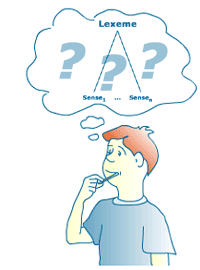Overview
 The phenomenon of ambiguity, i.e. that an expression has two or
more distinct meanings, is pervasive at all levels of the linguistic system:
The phenomenon of ambiguity, i.e. that an expression has two or
more distinct meanings, is pervasive at all levels of the linguistic system:
- Phonetics / Phonology
- /'aiskri:m/ (I scream vs. ice-cream)
- /nait/ (night vs. knight)
- Morphology
- I went there yesterday. (event past)
- If I went there by train, it would be cheaper. (hypothetical past)
- incapable: {in-} + {cap} + {-able} : {in} = NOT
- inflammable: {in-} + {flamm} + {-able} : in = INTO
- Syntax
- They can fish. (can = AUX or VRB)
- John read the book on the bed. (on the bed: John or the book)
- Semantics
- Everybody needs somebody. (Does everybody see the same?)
- John saw Superman on his way to New York. (his: John or Superman)
- Everybody needs somebody. (Does everybody see the same?)
- Pragmatics
- It's cold in here (a stement or a request)
- We'll come to your party on Saturday!>! (a promise or a threat)
However, the ambiguity usually disappears if the potentially ambiguous expression appears in an appropriate context which allows one of its meanings to be automatically selected. In fact, alternative readings, which would be preferred in other contexts, may not even come to mind.
** Test your own intuitions with some ambiguity examples **
Natural-language utterances may involve one or several of the following types of ambiguity:
- Video Notes (PDF)
